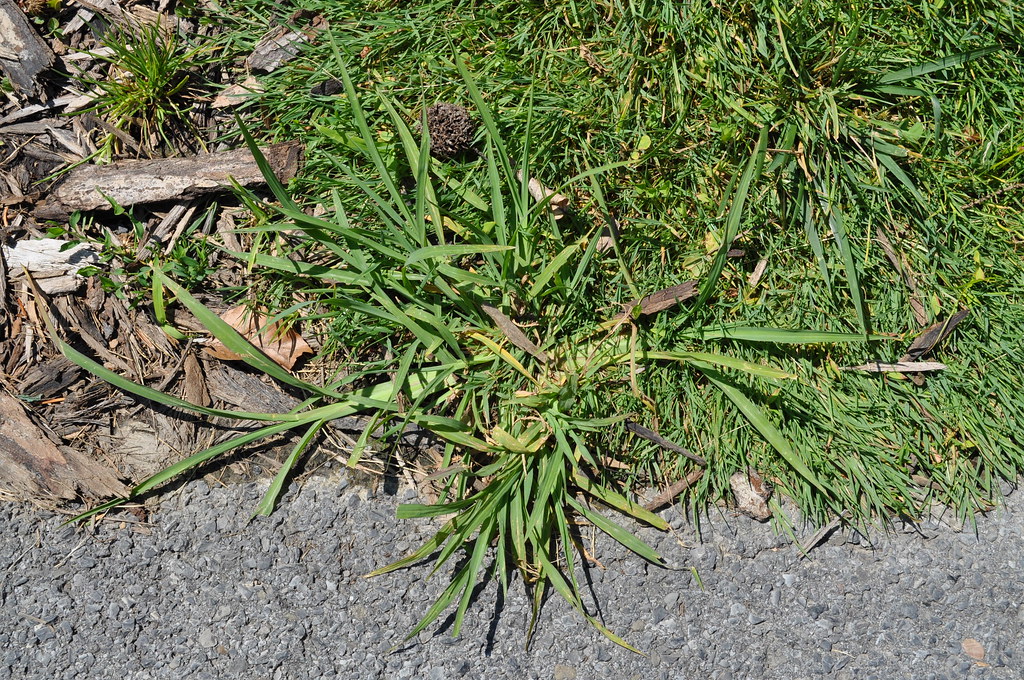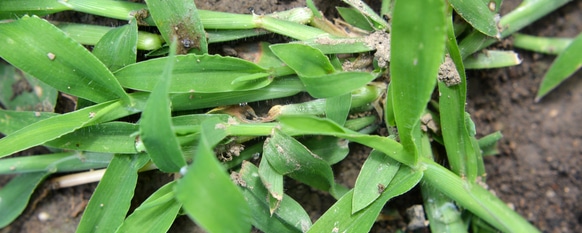Annual weeds have a unique way of invading landscapes. They rely on prolific seed production to saturate an area with their progeny. If only a single plant grows to maturity, it is capable of producing thousands of offspring.
Digitaria species, commonly called crabgrass, use this tactic to take over lawns, landscape beds, and other garden spaces. Once established, removing it is time-consuming, challenging, and expensive. The key to controlling it is never to let it grow to maturity.
The good news about this aggressive weed is that it is more annoying than dangerous. Although the habit of colonizing sparsely covered lawn space is bothersome, it is an indicator that the turf was stressed beforehand.
The annoyance of having weeds of a different color and texture than the lawn grass is eased by the fact that it covers bare ground quickly to protect the soil. It also makes a nutritious pasture grass for livestock, and a healthy cereal crop for people in some cultures, so it’s not all bad. But, most of us won’t eat our lawns, so follow along to learn more about preventing and controlling crabgrass.
If you have hickory trees on your property, make sure to check out our comprehensive guide on hickory trees to ensure that you are taking care of it correctly.

General Information
Crabgrass is an annual weed that germinates in spring when the soil temperature rises above 55 degrees Fahrenheit. Then it takes advantage of open soil space and thin patches in sunny lawns, landscape beds, and gardens. The seedlings grow into low, spreading mats of dense blue-green foliage.
As the plants mature, their jointed stems reach out like crab legs, with nodes that grow roots wherever they touch the soil. Seed production begins in just six to eight weeks and continues through fall. Crabgrass plants die with the onset of cold weather in fall and winter.
Early season seeds drop to the ground and germinate quickly to increase the plant population all summer long. Seeds from late summer and fall lie dormant through the winter until germination conditions return in the spring. Each crabgrass plant produces up to 150,000 viable seeds in a growing season. Dormant seeds can remain viable for up to 30 years in the soil.
So, we are presented with at least two challenges. First, if it is not currently in the yard, how can we keep it that way? Second, if it is present, how do we get rid of it? Both prevention and elimination start with the health of the lawn grass.

Controlling It in Your Lawn
The best approach to lawn weed control is to provide the right growing conditions for a healthy, vigorous lawn. Each lawn grass species performs best when the sunlight, soil pH, nutrient levels, water, and mowing height are within optimal ranges. Learn about your grass, and give it what it needs. In an environment where the grass grows a strong, healthy root system, and dense foliage, most weeds will be excluded, including crabgrass.
Some common mistakes that lead to weed infestations include mowing too low or infrequently, watering too often, and removing grass clippings. Avoid scalping the lawn, which creates bare spots. Mow the grass often enough to maintain the proper height without cutting more than 25 to 30 percent of the overall height at a time. Irrigate no more than three times per week, and only when the additional water is needed. Recycle nutrients and shade the soil by mulching grass clippings and leaving them on the lawn.
If the lawn is stressed or sparse, weeds will quickly invade. It is much easier to prevent crabgrass than to kill it after it appears. Although some herbicides can kill crabgrass, these products typically require multiple applications for full control. Instead, use a pre-emergent weed preventer to keep crabgrass seeds from sprouting. Apply crabgrass preventer in the late winter or early spring, and again 8 to 10 weeks later.
Sometimes a stray weed still finds its way into the yard. If there are only a few, dig them out right away, before they have a chance to spread seeds. Then review your lawn maintenance practices. Consider moving the mower height a notch or two higher or reducing irrigation. Use post-emergent herbicide as a last resort.

We recommend that you also check out our guide on how to raise fescue grass.
Controlling It in Gardens and Landscape Beds
This notorious invader of lawn space can be just as problematic in gardens and landscape beds that include areas of bare soil or mulch. In landscape beds, crabgrass preventer may be used effectively as in lawns, although the exact product used on the lawn may not work for flower beds. Choose a weed preventer, such as Bonide’s preventer, specifically designed for use in landscape beds, and follow the label instructions.
In vegetable gardens and other organic growing environments, corn gluten-based weed preventer can be an effective crabgrass preventer. Other means of control include frequent, shallow cultivation, flame weeding, and smothering.
Know Your Foe
Crabgrass spreads quickly after germination to form a sprawling clump. Within a few weeks, the telltale crab leg stems begin to form. The grass blades are dull green and about .25 inch wide.
Beware of confusing lookalike weeds. Tall fescue, bromegrass, bermuda grass, bromegrass, orchard grass, yellow foxtail, and others could take root and become a nuisance. Some germinate in cool weather, and others are perennials. An effective crabgrass treatment could make other weed problems worse.



